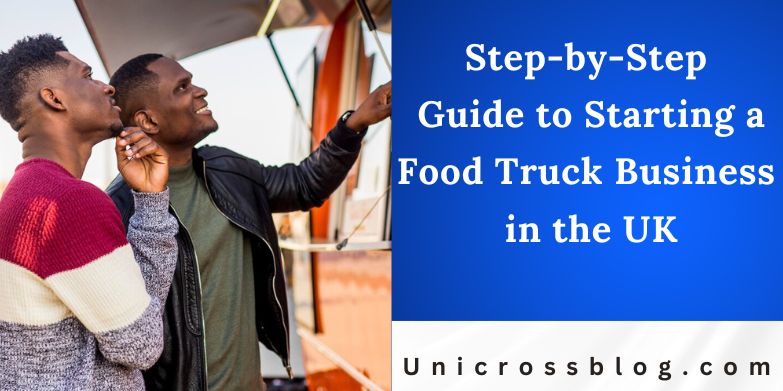Starting a food truck business in the UK can be an exhilarating way to turn your passion for cooking into a profitable venture. With the street food market valued at over £1.2 billion and growing at 20% annually, food trucks offer flexibility, lower overheads than traditional restaurants, and the chance to connect directly with customers at markets, festivals, and events. In 2025, trends like sustainable sourcing, plant-based options, and tech-integrated operations (such as mobile POS systems) are shaping the industry, making it an ideal time to launch. However, success demands careful planning—from navigating regulations to managing costs.
This guide provides a step-by-step roadmap, drawing on current best practices, to help you hit the road confidently. Whether you’re slinging gourmet burgers or artisanal coffee, expect startup costs of £8,500 to £75,000, with potential annual revenues up to £100,000 for established trucks.

Step-by-Step Guide to Starting a Food Truck Business in the UK
Step 1: Develop Your Concept and Conduct Market Research
Begin by defining your unique selling point. What cuisine will you specialize in street tacos, vegan wraps, or fusion fish and chips? Research local demand by surveying potential customers, analyzing footfall at events, and studying competitors. Visit food markets in cities like London or Manchester to identify gaps, such as underserved late-night crowds or eco-friendly options.
Tools like free online surveys or social media polls can help gauge interest. Consider 2025 trends: health-conscious menus and Instagram-worthy dishes drive sales. Aim for a niche that aligns with your skills and keeps operations simple—food trucks thrive on quick, repeatable items. This step typically takes 1-2 months and costs little beyond your time.
Step 2: Create a Detailed Business Plan
A solid business plan is your roadmap and funding pitch. Outline your concept, target market, menu, pricing, and financial projections. Include startup costs (e.g., £30,000-£200,000 for the truck and fit-out), ongoing expenses (fuel, ingredients at 30-35% of revenue), and revenue goals (aim for £500-£1,000 daily in peak seasons).
Project break-even within 12-18 months, factoring in seasonal dips. Use templates from resources like the British Business Bank for structure. This document not only clarifies your vision but also supports loan applications. Dedicate 2-4 weeks to drafting, and revisit it quarterly.
Step 3: Handle Legal and Regulatory Requirements
Compliance is non-negotiable to avoid fines up to £5,000 or closure. Register your business as a sole trader, partnership, or limited company with HMRC within 3 months of starting—it’s free and covers self-assessment tax. All food businesses must register with your local council’s environmental health team at least 28 days before trading; this is also free but triggers inspections.
Key licenses include:
- Food Business Registration: Mandatory for hygiene oversight.
- Street Trading License: £100-£1,000 annually from your local council, specifying trading spots.
- Food Hygiene Rating: Prepare for a 0-5 star inspection; display it (required in Wales/Northern Ireland).
- HACCP Plan: A free hazard analysis template from the Food Standards Agency to manage food safety risks.
- Gas Safety Certificate: £50-£100 for commercial appliances.
- Level 2 Food Hygiene Certificate: £20-£30 online course for handlers; Level 3 for managers.
If serving alcohol, apply for a Temporary Events Notice (£21 per event). For vehicles over 3.5 tonnes, upgrade to a C1 driving license (£50 test). Budget £500-£2,000 for all permits. Consult the Food Standards Agency for 2025 updates on labelling and allergens.
Step 4: Secure Funding
Startup costs vary: basic setups at £8,500 (used van, minimal kit), mid-range at £30,000-£50,000, or premium at £75,000+ for custom builds. Breakdown:
- Vehicle: £20,000-£100,000 (buy used to save 50%).
- Equipment (grills, fridges): £5,000-£15,000.
- Initial inventory: £1,000-£2,000.
- Licenses/insurance: £1,000-£3,000.
- Marketing: £500-£2,000.
Funding options:
- Personal savings or family loans for quick starts.
- Government-backed Start Up Loans: Up to £25,000 at 6% fixed interest, plus free mentoring.
- Bank loans or equipment finance: 5-10% interest, secured against assets.
- Crowdfunding: Platforms like Kickstarter for £5,000-£20,000 via backer perks (e.g., free meals).
- Grants: Check UK Startups for small business funds targeting food innovation.
Build a 3-6 month emergency fund for slow periods. Aim to secure funds in 1-3 months.
Step 5: Acquire and Equip Your Food Truck
Decide between buying (£20,000+ for a fitted van), leasing (£500/month), or converting a standard vehicle (£10,000-£30,000). Opt for fuel-efficient models to cut running costs (£0.20-£0.50/mile). Essential equipment: commercial cooker, extraction hood, fridge/freezer, handwash sink, and generator (£1,000-£5,000).
Ensure compliance with fire safety (extinguishers, £100) and waste disposal (grey water tank). Source from suppliers like Nisbets for deals. Test setups for efficiency—e.g., propane vs. electric. This phase takes 4-8 weeks; hire a fitter for £2,000-£5,000 if converting.
Step 6: Set Up Operations and Suppliers
Streamline daily ops with a POS system (£200-£500) for cashless payments and inventory tracking—vital as 70% of sales are card-based in 2025. Source ingredients from wholesalers like Booker for bulk savings (aim for 25-30% food cost margin). Develop a menu of 5-10 items to minimize waste (£0.97/meal average loss).
Hire 1-2 staff if needed (£11.44/hour minimum wage); train on hygiene. Plan routes: festivals for high volume (£2,000/day potential), offices for steady lunch trade. Use apps like Street Food Finder for bookings. Launch soft trials to refine processes.
Step 7: Market and Launch Your Business
Build buzz pre-launch: Create a memorable name/logo (£200-£500 design) and social media presence (Instagram/TikTok for 80% of discoveries). Partner with events via the Nationwide Caterers Association. Budget £500 for flyers, signage, and geo-targeted ads.
Track metrics like customer acquisition cost (£5-£10/visitor). Aim for 50-100 daily customers initially. Post-launch, gather feedback via QR codes to iterate.
Step 8: Monitor, Adapt, and Scale
Track finances weekly: Revenue minus costs (35% ingredients, 20% labor, 10% fuel/insurance). Use software like Square for insights. Adapt to seasons—indoor markets in winter. Scale by adding trucks or pop-ups once profitable (18-24 months). Join associations for networking and insurance discounts.
READ ALSO: 10 Marketing Strategies Every Entrepreneur Should Know
FAQs
How much does it cost to start a food truck in the UK?
Expect £8,500-£75,000 initially, covering vehicle, equipment, and licenses. Used options keep it under £30,000; custom builds push higher. Ongoing: £2,000-£5,000/month.
Do I need insurance for my food truck?
Yes—public liability (£100-£300/year) covers accidents; vehicle insurance (£500-£1,000) is mandatory. Employer’s liability (£50+) if hiring staff. Bundle for savings.
Can I park my food truck anywhere?
No—secure a street trading license for specific spots. Private land needs owner permission; avoid residential areas. Councils prioritize high-footfall zones like markets.
How long until my food truck turns profitable?
12-24 months typically, with break-even at £50,000-£100,000 annual revenue. Focus on high-margin items (60%+ gross) and low-waste ops.
What food hygiene training do I need?
Level 2 for handlers (£20-£30, 2 hours online); Level 3 for supervisors. All staff must complete it; refresh every 3 years.
How do I handle food waste and sustainability?
Implement inventory tracking to cut £0.97/meal losses. Use local, seasonal suppliers for eco-appeal—2025 customers prioritize green practices.
Can I start with no experience?
Possible with passion and training, but culinary background helps. Test via pop-ups; join mentorship programs for guidance.







